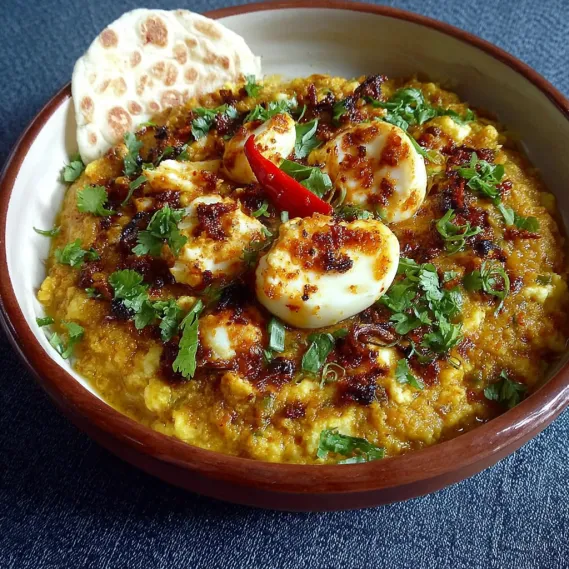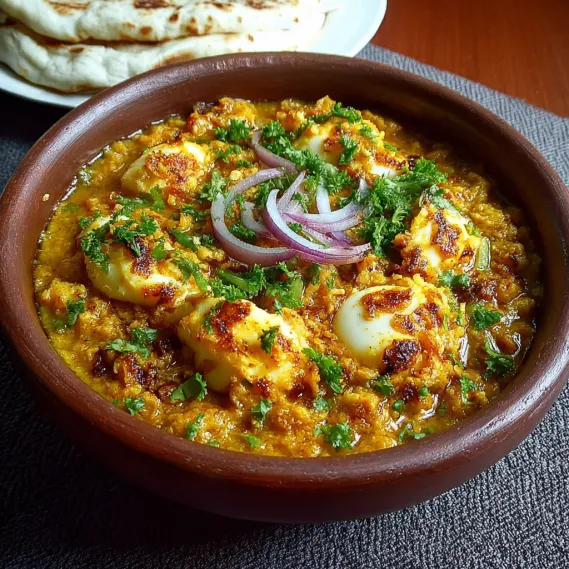 Pin
Pin
This hearty Bengali Egg Tadka has been my weekend comfort food staple for years. The beautiful marriage of lentils and scrambled eggs creates a perfectly balanced dish that's both nutritious and satisfying. The aromatic spices bring warmth and depth that transforms simple ingredients into something truly special.
I discovered this recipe during my exploration of regional Indian cuisine and it quickly became a family favorite. My children, who typically shy away from lentil dishes, ask for second helpings whenever I make this flavorful tadka.
Ingredients
- Whole green moong dal: adds earthiness and holds its shape beautifully
- Chana dal Bengal gram: adds a nutty flavor and creamy texture
- Eggs: provide protein and richness to the dish
- Bay leaf: infuses a subtle aromatic quality that elevates the entire dish
- Kasuri methi dried fenugreek leaves: are essential for authentic flavor
- Kashmiri red chili powder: adds vibrant color without excessive heat
- Garam masala: rounds out the flavor profile with warming spices
Step-by-Step Instructions
- Prepare the Lentils:
- Soak both lentils together for 2-3 hours to ensure even cooking. This step is crucial for proper texture. Pressure cook with turmeric and salt for exactly 3 whistles over low flame. Allow pressure to release naturally for the perfect consistency.
- Scramble the Eggs:
- Beat eggs with a pinch of salt until fully incorporated. Heat oil until shimmering but not smoking. Pour beaten eggs into the pan and wait 10-15 seconds before gently scrambling with a spatula. The eggs should be soft and just set. Remove immediately to prevent overcooking.
- Create the Flavor Base:
- Heat oil and butter together until the butter melts completely. Add bay leaf and allow it to infuse the oil for 30 seconds. Add onions and sauté until they turn translucent and begin to brown at the edges. The slow caramelization builds incredible depth of flavor.
- Develop the Aromatics:
- Add ginger, garlic and green chili, cooking until the raw smell disappears and they become fragrant. This usually takes about 2 minutes. The kitchen will fill with an irresistible aroma at this stage.
- Build the Spice Layer:
- Add turmeric and chili powder, stirring constantly to prevent burning. These spices need just 30 seconds to bloom in the hot oil. Add tomatoes and salt, cooking until tomatoes break down completely and become jammy.
- Combine and Finish:
- Pour the cooked dal into the spice mixture, stirring gently to incorporate. Allow flavors to meld for 2 minutes. Fold in scrambled eggs, kasuri methi, and garam masala. The final resting period allows all flavors to harmonize beautifully.

The kasuri methi powder is truly my secret weapon in this recipe. I discovered its importance during a cooking class with a Bengali chef who insisted it was non negotiable. The first time I made this dish without it, my family immediately noticed something was missing. That earthy, slightly bitter note is what makes this tadka truly authentic.
Perfecting Your Dal Texture
The consistency of your dal can make or break this dish. For the ideal tadka, aim for a medium thickness that coats the back of a spoon but still flows gently. If your dal becomes too thick after cooking, add hot water a tablespoon at a time while stirring. For dal that's too thin, simmer uncovered for a few extra minutes to reduce. Remember that the dal will continue to thicken slightly as it cools, so err on the side of a slightly thinner consistency when serving hot.
Make It Your Own
This versatile dish welcomes adaptations based on what you have available. Replace moong dal with masoor red lentil for a quicker cooking time, though the texture will be softer. For added vegetables, spinach or finely diced bell peppers blend beautifully into the gravy. Enhance the protein content by increasing eggs or adding paneer cubes during the final simmer. Vegans can skip the eggs entirely and add cubed tofu for a similar textural experience. The foundation spices remain the same regardless of your adaptations.
Serving Suggestions
Serve this egg tadka with fresh, hot basmati rice for a traditional experience. The subtle fragrance of basmati complements the spiced gravy perfectly. For a complete meal, add a side of quick cucumber raita to provide cooling contrast. If serving as part of a larger spread, pair with naan or roti for scooping up the flavorful gravy. A final touch of ghee or butter melting on top adds incredible richness and sheen, making this humble dish worthy of special occasions.
Cultural Context
Egg tadka represents the beautiful culinary heritage of Bengal, where lentils and eggs are dietary staples. This dish emerged as a practical solution for adding protein to vegetable based meals. In traditional Bengali households, this dish often appears during late monsoon seasons when fresh vegetables are scarce but pantry items remain abundant. The combination of lentils and eggs provides complete protein, making it nutritionally significant in regions where meat consumption might be limited by availability or religious practices.
Common Questions About This Recipe
- → What dals are best for this dish?
The classic choice is a mix of whole green moong dal and chana dal, but you can experiment with other dals if needed.
- → How spicy is Bengali egg tadka?
It uses both green chili and Kashmiri red chili powder, but you can easily adjust the heat by using milder chilies or reducing the quantity.
- → Can I skip eggs for a vegetarian version?
Yes, simply omit the scrambled eggs for a tasty plain tadka, or add more dal to keep the texture rich.
- → What are the best pairings for this dish?
It pairs beautifully with roti, paratha, or steamed basmati rice, making a complete and satisfying meal.
- → Is kasuri methi essential?
While kasuri methi powder adds a distinct aroma, you can use regular kasuri methi or skip it if unavailable.
- → How do I get fluffy scrambled eggs?
Beat the eggs well with a pinch of salt and scramble quickly in hot oil for soft, tender curds.
